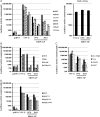Comparative Analysis of Host Cell Entry of Ebola Virus From Sierra Leone, 2014, and Zaire, 1976
- PMID: 25840443
- PMCID: PMC4564534
- DOI: 10.1093/infdis/jiv101
Comparative Analysis of Host Cell Entry of Ebola Virus From Sierra Leone, 2014, and Zaire, 1976
Abstract
The ongoing Ebola virus (EBOV) disease (EVD) epidemic in Western Africa is the largest EVD outbreak recorded to date and requires the rapid development and deployment of antiviral measures. The viral glycoprotein (GP) facilitates host cell entry and, jointly with cellular interaction partners, constitutes a potential target for antiviral intervention. However, it is unknown whether the GPs of the currently and previously circulating EBOVs use the same mechanisms for cellular entry and are thus susceptible to inhibition by the same antivirals and cellular defenses. Here, we show that the GPs of the EBOVs circulating in 1976 and 2014 transduce the same spectrum of target cells, use the same cellular factors for host cell entry, and are comparably susceptible to blockade by antiviral interferon-induced transmembrane proteins and neutralizing antibody KZ52. Thus, the viruses responsible for the ongoing EVD epidemic should be fully susceptible to established antiviral strategies targeting GP and cellular entry factors.
Keywords: Ebola virus; West Africa; entry; glycoprotein.
© The Author 2015. Published by Oxford University Press on behalf of the Infectious Diseases Society of America.
Figures






References
-
- World Health Organization (WHO). Ebola. Geneva: WHO, 2014. Available at: http://www.who.int/mediacentre/factsheets/fs103/en/. Accessed 19 March 2015.
-
- Baize S, Pannetier D, Oestereich L, et al. Emergence of Zaire Ebola virus disease in Guinea. N Engl J Med 2014; 371:1418–25. - PubMed
Publication types
MeSH terms
Substances
LinkOut - more resources
Full Text Sources
Other Literature Sources
Medical

